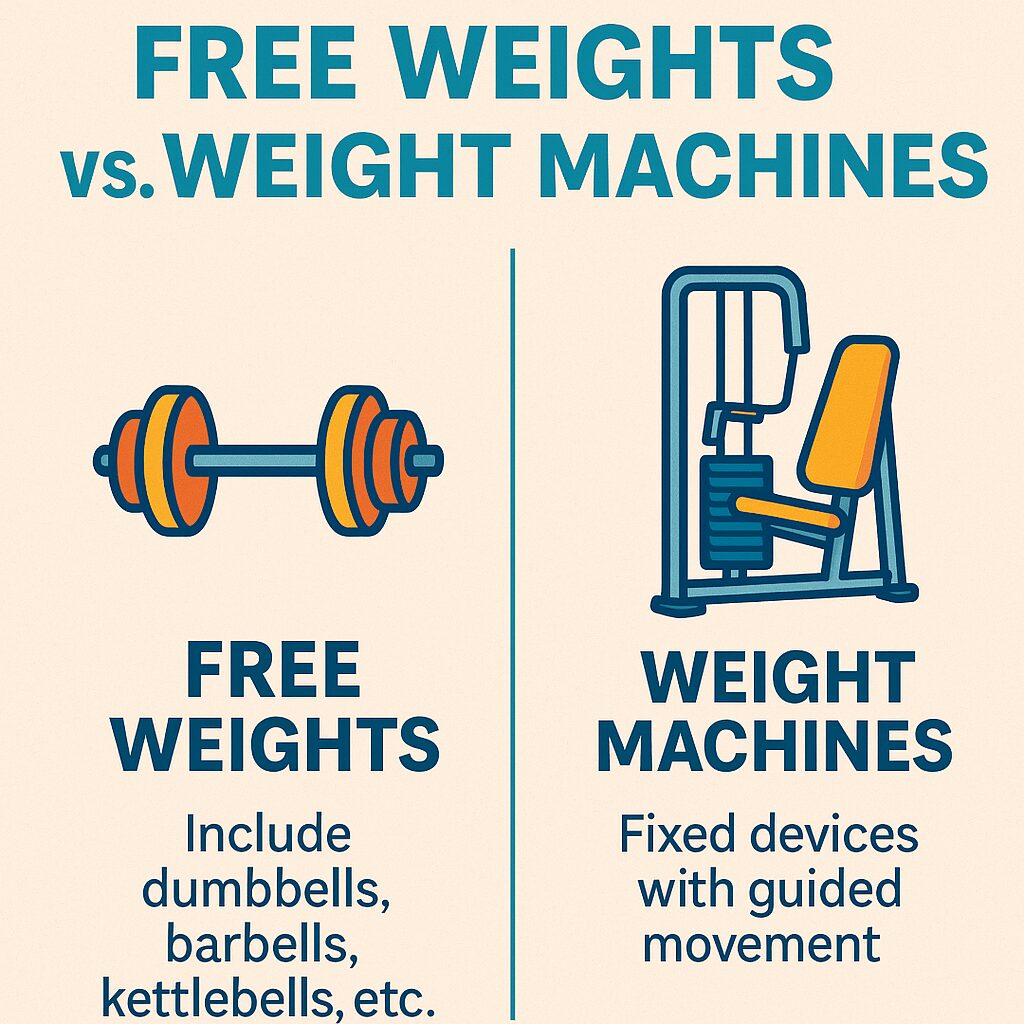When it comes to strength training, the choice between free weights and weight machines often sparks debate. Both have unique benefits and drawbacks, and the right option depends on your fitness goals, experience level, and personal preferences. This article breaks down the pros and cons of free weights and weight machines, helping you determine which is best suited for your workout routine.
What Are Free Weights and Weight Machines?
Free Weights:
Free weights include dumbbells, barbells, kettlebells, and other equipment that allow unrestricted movement. They require balance, coordination, and stabilization, offering a versatile approach to strength training.
Weight Machines:
Weight machines are fixed devices designed to guide your movement along a predetermined path. These include cable machines, leg presses, and chest press machines. They often come with adjustable weight stacks for resistance.
Benefits of Free Weights
1. Full Range of Motion
Free weights allow for natural, unrestricted movements, engaging a broader range of muscles. This promotes functional strength and better mimics real-life activities.
2. Improves Stabilization and Balance
Since you control the weight, free weights activate stabilizer muscles. This enhances balance, coordination, and core strength.
3. Versatility
Free weights are incredibly versatile. With a single set of dumbbells or a barbell, you can perform countless exercises targeting every muscle group.
4. Functional Strength Training
Free weight exercises often replicate movements used in daily life or sports, making them ideal for building practical strength.
5. Cost-Effective and Space-Saving
For home workouts, free weights are more affordable and take up less space compared to weight machines.
Drawbacks of Free Weights
1. Risk of Injury
Improper form or lifting heavy weights without supervision can lead to injuries, especially for beginners.
2. Learning Curve
Free weights require knowledge of proper technique and body mechanics, which can be intimidating for newcomers.
3. Longer Setup Time
Adjusting weights, setting up racks, or transitioning between exercises can be time-consuming compared to machines.
Benefits of Weight Machines
1. User-Friendly
Weight machines are easy to use, making them ideal for beginners who want to focus on building strength without worrying about technique.
2. Safety
Machines provide stability and guide your movement, reducing the risk of injury, especially when lifting heavy weights.
3. Isolates Specific Muscles
Weight machines allow you to target specific muscle groups more effectively, making them great for rehabilitation or addressing imbalances.
4. Quick and Convenient
Adjusting resistance on a machine is straightforward, allowing for faster transitions between exercises.
5. Accessible for All Fitness Levels
Machines accommodate various fitness levels and physical limitations, offering a safe and effective option for seniors or those recovering from injuries.
 Drawbacks of Weight Machines
Drawbacks of Weight Machines
1. Limited Range of Motion
Machines follow a fixed path, which can restrict natural movement and reduce engagement of stabilizer muscles.
2. Lack of Functional Training
While machines target specific muscles, they don’t always mimic real-life movements, potentially limiting practical strength gains.
3. Cost and Space Requirements
Weight machines are expensive and take up significant space, making them less practical for home gyms.
4. Can Become Too Easy
Once you’re accustomed to a machine’s movement pattern, it may feel less challenging compared to free weights.
Choosing Between Free Weights and Weight Machines
When to Choose Free Weights
- Building Functional Strength: Free weights are ideal for improving coordination, balance, and athletic performance.
- Advanced Training: Experienced lifters benefit from the versatility and muscle engagement of free weights.
- Cost-Effective Home Workouts: If you’re setting up a home gym on a budget, free weights are a smart choice.
When to Choose Weight Machines
- Beginners: Machines provide a controlled environment for learning the basics of resistance training.
- Rehabilitation: Machines are excellent for isolating muscles during recovery.
- Targeted Training: Use machines to focus on specific muscles without relying on stabilizers.
- Time Efficiency: If you’re short on time, machines allow quick adjustments and transitions.
Can You Combine Both?
Yes! Many effective training programs combine free weights and machines to maximize benefits. For example:
- Use free weights for compound lifts like squats, deadlifts, and bench presses to build overall strength.
- Incorporate machines for accessory exercises like leg extensions or tricep pushdowns to isolate specific muscles.
Sample Hybrid Workout Plan
Day 1: Upper Body
- Barbell Bench Press (Free Weights)
- Dumbbell Rows (Free Weights)
- Lat Pulldown (Machine)
- Chest Fly (Machine)
Day 2: Lower Body
- Barbell Squats (Free Weights)
- Romanian Deadlifts (Free Weights)
- Leg Press (Machine)
- Seated Calf Raise (Machine)
Day 3: Core and Stabilizers
- Kettlebell Swings (Free Weights)
- Cable Woodchoppers (Machine)
- Hanging Leg Raises (Bodyweight/Free Weights)
Common Mistakes to Avoid
- Skipping Warm-Ups: Always warm up to prepare your muscles and joints, whether using free weights or machines.
- Neglecting Form: Poor technique with free weights or machines can lead to injuries. Focus on proper mechanics.
- Overreliance on Machines: Don’t avoid free weights entirely; they’re essential for building functional strength.
Conclusion: The Best Tool for Your Goals
The choice between free weights and weight machines isn’t a matter of which is better—it’s about which suits your needs and goals. For functional strength, versatility, and long-term progression, free weights are unparalleled. For safety, muscle isolation, and accessibility, weight machines are invaluable. A balanced approach that leverages the strengths of both can take your training to the next level.
References
-
Schoenfeld, B. J. (2010). The mechanisms of muscle hypertrophy and their application to resistance training. Journal of Strength and Conditioning Research, 24(10), 2857–2872. https://doi.org/10.1519/JSC.0b013e3181e840f3
-
Ratamess, N. A. (Ed.). (2011). ACSM’s Foundations of Strength Training and Conditioning. Wolters Kluwer Health/Lippincott Williams & Wilkins.
-
Behm, D. G., & Sale, D. G. (1993). Velocity specificity of resistance training. Sports Medicine, 15(6), 374–388. https://doi.org/10.2165/00007256-199315060-00005
-
American College of Sports Medicine. (2021). ACSM’s Guidelines for Exercise Testing and Prescription (11th ed.). Wolters Kluwer.
-
Król, H., & Piech, K. (2020). Free weights versus machines in resistance training: A review. Journal of Physical Education and Sport, 20(6), 3536–3543. https://doi.org/10.7752/jpes.2020.06478
-
Atha, J. (1981). Strengthening muscle. Exercise and Sport Sciences Reviews, 9(1), 1–73. https://doi.org/10.1249/00003677-198100090-00002
-
Willardson, J. M. (2007). The application of training to failure in periodized multiple-set resistance exercise programs. Journal of Strength and Conditioning Research, 21(2), 628–631. https://doi.org/10.1519/R-20326.1
-
Phillips, S. M. (2000). Short-term training: when do repeated bouts of resistance exercise become training? Canadian Journal of Applied Physiology, 25(3), 185–193. https://doi.org/10.1139/h00-013
-
Stone, M. H., Stone, M., & Sands, W. A. (2007). Principles and Practice of Resistance Training. Human Kinetics.
-
Schwanbeck, S., Chilibeck, P. D., & Binsted, G. (2009). A comparison of free weight squat to Smith machine squat using electromyography. Journal of Strength and Conditioning Research, 23(9), 2588–2591. https://doi.org/10.1519/JSC.0b013e3181b1b181


 * [Santelog – First Steroid Cycle 2025: Experts Discuss Science Behind Beginner’s Guide](https://www.santelog.com/actualites-sante-nasdaq/first-steroid-cycle-2025-experts-discuss-science-behind-beginners-guide?utm_source=chatgpt.com) * [Swolverine – Testosterone for Beginners: Foundation of All Steroids](https://swolverine.com/blogs/blog/testosterone-for-beginners-what-you-need-to-know-about-the-foundation-of-all-steroids?srsltid=AfmBOoqCC-dSYCCLzS_aBUE9R2UrzUwlIeQTThc1SHtn0PrDe-sUv5tK&utm_source=chatgpt.com) * [Swolverine – Ultimate Guide to Post Cycle Therapy](https://swolverine.com/blogs/blog/ultimate-guide-to-post-cycle-therapy-reclaim-your-gains-and-restore-hormonal-balance?srsltid=AfmBOoqIedo-hSzwJWKVyOakO8QOG8Ex4eQPq8T0ZgfbDGumXh4v0gKN&utm_source=chatgpt.com) * [Swolverine – Cycle Length by Compound: Steroids, SARMs, Peptides](https://swolverine.com/blogs/blog/cycle-length-by-compound-steroids-sarms-peptides-full-guide-for-bodybuilders?srsltid=AfmBOop_lD04o8YU_g2b_B6B7MysdBhMn-DjUTpJ2i8gsPVyntVWRFW2&utm_source=chatgpt.com) * [Harley Street MD – Post Cycle Therapy Guide](https://harleystreet-md.co.uk/blog/post-cycle-therapy/?utm_source=chatgpt.com) * [Ro Health – Clomid for Post Cycle Therapy](https://ro.co/erectile-dysfunction/clomid-for-post-cycle-therapy/?utm_source=chatgpt.com) * [Endocrine Society – Press Release: Post-Cycle Therapy Research](https://www.endocrine.org/news-and-advocacy/news-room/2023/endo-2023-press-jayasena?utm_source=chatgpt.com) * [NCBI Bookshelf – Testosterone Cypionate Clinical Use](https://www.ncbi.nlm.nih.gov/books/NBK482418/?utm_source=chatgpt.com) * [PMC – Patterns and Side Effects of Anabolic Steroid Use](https://pmc.ncbi.nlm.nih.gov/articles/PMC10640727/?utm_source=chatgpt.com) --- anabolic steroids, first cycle, beginners guide, testosterone enanthate, testosterone cypionate, bodybuilding tips, steroid cycle plan, post cycle therapy, PCT guide, Clomid, Nolvadex, testosterone suppression, sexual recovery, steroid side effects, safe steroid use, hormone recovery, training optimization, steroid psychology, cycle length, beginner cycle, health monitoring, injection cycle, estrogen control, hormonal suppression, testosterone dosage, recovery protocol, steroid education, controlled cycle, responsible cycle, muscle health](https://steroidology.com/wp-content/uploads/2025/09/istockphoto-597631958-612x612-1.jpg)




